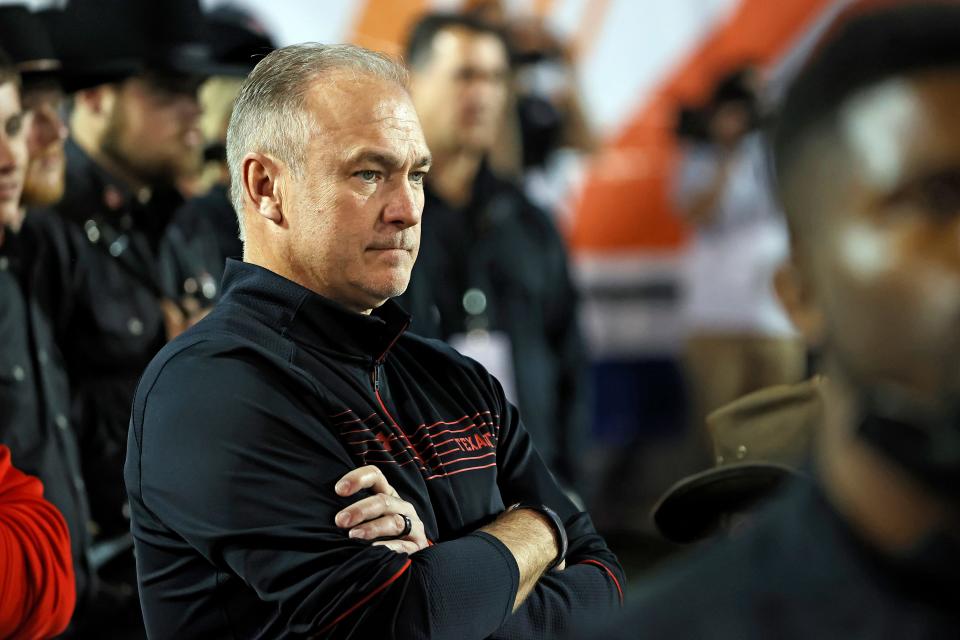With reduced rosters coming to college football, what number will satisfy Joey McGuire?
Reports over the past two weeks have suggested major-college football teams soon will be working with a roster limit of 105 players. That's in the aftermath of the proposed settlement in the class-action House v. NCAA case.
Scholarship caps are being eliminated under the proposal, but roster limits will be set. When the proposed settlement was reached two months ago, some coaches feared a roster cap as low as 85 could be imposed on FBS teams, effectively eliminating walk-on opportunities.
ESPN, Yahoo Sports and The Athletic all have reported 105 as the target number being discussed by conference commissioners. If that's the number ultimately agreed upon, Joey McGuire would be OK with it.
"I think 105 would be a really good number," the Texas Tech football coach said. "I think when you start talking 85, you're not talking a roster of 85. If you are, you're going to cut high-school recruiting totally out, because if you're talking 85, 20 of those freshmen are not ready to play down in and down out — as much as they think they are, as much as everybody's promised them they're going to play.
"So you're really taking, like, 60 into a game. Well, when you're playing week 10, that 60 turns into 50 or less (healthy players). So just for health and safety of your players, you need to be able to get to 100 to 105."
How to grow revenue: Brett Yormark, Linda Livingstone discuss challenge of college sports' new landscape
Positioned for parity: Brett Yormark declares Big 12 football 'will be the deepest conference in America'
The NCAA set a football scholarship limit of 105 in 1973 in response to Title IX, then reductions to 95 in 1978 and the current 85 in 1992.
However, walk-ons augment roster sizes well beyond the scholarship limits. Texas Tech, for example, listed 121 players on its 2022 roster and 114 during spring football this year, the latter number not counting a few additional walk-ons who practiced with the team but were never listed on the roster. Roster cuts after spring football common.
Only 105 players can take part in preseason practice before fall-semester classes start.
Texas Tech officials say they'll be ready for era of revenue-sharing with athletes
The long form of the proposed settlement in House vs. NCAA is expected to be filed Friday, according to multiple reports, after which it still must receive court approval. As part of the proposal, the NCAA would pay $2.77 billion over a 10-year period to college athletes who played before July 2021, when athletes were first allowed to monetize their name, image and likeness.
A separate component of the proposed settlement is revenue sharing under which schools can distribute to their athletes an amount starting at a little more than $20 million per year. Over the past decade, Texas Tech has fully funded optional initiatives such as scholarships to cover full cost of attendance, as well as education-related benefits known as Alston awards.
Related: Texas Tech stipends to be among the largest
Related: Tech to offer athletes $5,980 annually in academic awards
Related: Tech athletes in portal early DQed from first Alston checks
Those financial outlays, each between $1 million and $2 million total annually, require far less financial commitment than the revenue-sharing model under discussion. The latter could take up more than 15 percent of the annual Texas Tech athletics budget.
Revenue sharing in the amount of $20 million-plus per year is expected to begin in the fall of 2025. The Tech athletics budget for the upcoming school year is expected to be about $128 million to $129 million, deputy athletics director Jonathan Botros said, subject to approval in August by the Tech University System Board of Regents in August.
In a public social-media exchange this summer with TCU athletics director Jeremiah Donati, Tech athletics director Kirby Hocutt said Tech plans "on revenue sharing at the highest level."
Asked at the end of June about Tech's capability to dispense many millions directly to athletes, Botros said, "I'll just reiterate what Kirby shared, which is that it's been a discussion topic all the way up to the board (of regents) level at Texas Tech and right now, based on the information we know about the pending settlement, our plan at this time is to revenue share at the highest level possible. That is our plan as of today."
Speaking this month at Big 12 media days in Las Vegas, McGuire struck a similar chord.
"I know whenever it comes to revenue sharing, we will be extremely aggressive," the Red Raiders' coach said. "Whatever that number is, we'll be at the max. ...
"Right now, some different schools not in this conference say the Big 12 doesn't have the same amount of money in revenue share. Well, everybody has the same amount of money. It's your choice if you're going to use that money or not.
"Our choice (at) Texas Tech is we're going to share at the highest level, and that's the highest level that LSU has. That's the highest level that Auburn has. That's the highest level that Alabama has. Whatever that level they set, that's what we're sharing at."

This article originally appeared on Lubbock Avalanche-Journal: Reduced rosters are coming; what number can Joey McGuire live with?

